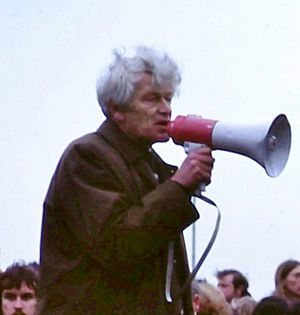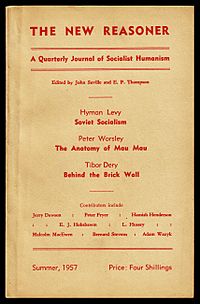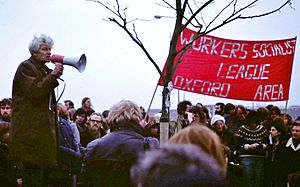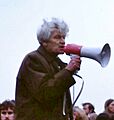E. P. Thompson facts for kids
Quick facts for kids
E. P. Thompson
|
|
|---|---|

Thompson at a 1980 protest rally
|
|
| Born |
Edward Palmer Thompson
3 February 1924 Oxford, England
|
| Died | (aged 69) Upper Wick, England
|
| Alma mater | Corpus Christi College, Cambridge |
| Spouse(s) |
Dorothy Towers
(m. 1948) |
|
Influences
|
|
Edward Palmer Thompson (1924–1993) was an English historian, writer, and activist. He was known for his strong belief in fairness and peace. He is most famous for his book, The Making of the English Working Class (1963). This book explored the lives of ordinary working people in England during the late 1700s and early 1800s.
Thompson also wrote biographies of important figures like William Morris and William Blake. He was a busy journalist and essay writer. Many people believe his work was very important for understanding the history of workers and society in the 20th century. In 2011, a magazine called History Today named him the second most important historian of the past 60 years.
Thompson was a leading thinker in the Communist Party of Great Britain. He left the party in 1956 because he disagreed with how they handled the Soviet invasion of Hungary. Even after leaving, he continued to write history from a Marxist point of view. He wanted to see a change from the strict rule of Stalinism.
Thompson was also a key figure in the first New Left movement in Britain. He strongly criticized the Labour governments of the 1960s and 1970s. He was an early and constant supporter of the Campaign for Nuclear Disarmament. In the 1980s, he became a main leader in the movement against nuclear weapons in Europe.
Contents
Early Life and Education
E. P. Thompson was born in Oxford, England. His parents were Methodist missionaries. His father, Edward John Thompson, was a poet. His older brother, William Frank Thompson, was a British officer in the Second World War. Frank was captured and shot while helping anti-fascist fighters in Bulgaria.
Thompson went to two private schools: The Dragon School in Oxford and Kingswood School in Bath. In 1941, like many young people, he left school to fight in the Second World War. He served in a tank unit during the Italian campaign, including the battle of Cassino.
After the war, he studied at Corpus Christi College, Cambridge. There, he joined the Communist Party of Great Britain. In 1946, Thompson helped form the Communist Party Historians Group. This group included other famous historians like Christopher Hill and Eric Hobsbawm. In 1952, they started an important history journal called Past and Present.
Thompson's Career and Major Works
Writing About William Morris
Thompson's first big book was a biography of William Morris. He wrote this book while he was still part of the Communist Party. The book was titled From Romantic to Revolutionary. It aimed to show that Marxist ideas had roots in Britain. It also tried to highlight Morris's political work, which many critics had ignored.
Thompson's book also looked at Morris's early poetry. The first edition of the book (1955) didn't get much attention. This was likely because its Marxist viewpoint was not popular then. However, a rewritten second edition (1976) was much better received.
The First New Left Movement
In 1956, a speech by Nikita Khrushchev revealed the crimes of Joseph Stalin. Thompson and others were very upset by this. They started a publication called The Reasoner within the Communist Party. Six months later, Thompson and many friends left the party. They were disgusted by the Soviet invasion of Hungary.
But Thompson still believed in a "socialist humanist" way of thinking. With his friends, he started New Reasoner. This journal aimed to create a new kind of democratic socialism. It was different from the old, strict Marxism and the Cold War politics of the Labour Party. The New Reasoner became very important for the "New Left" movement. This movement was linked to the growing effort to get rid of nuclear weapons.
The New Reasoner later joined with another journal to form New Left Review in 1960. Thompson and his group later had disagreements with the new editors. Thompson then worked with the Socialist Register publication. He also helped write the 1967 May Day Manifesto. This was a major challenge to the Labour government at the time.
The Making of the English Working Class
Thompson's most famous book is The Making of the English Working Class. It was published in 1963 while he was teaching at the University of Leeds. This huge book, over 800 pages, was a turning point for social history. Thompson looked at the everyday lives of working people. He used old documents that others had ignored. He told the forgotten story of the first working-class political groups in the world. These groups appeared in the late 1700s and early 1800s.
The book had a huge impact on how British history was studied. It is still a key book for university students today. In the book's introduction, Thompson explained his goal. He wanted to "rescue" the forgotten people of history. These included factory workers, Luddites (people who destroyed machines), and hand-loom weavers. He wanted to show that their hopes and experiences were important.
Thompson's ideas were also new because of how he defined "class." He saw class as a relationship that changed over time. This idea opened the door for many other historians. They began to study the working classes in other countries, like America. Thompson wrote the book while living in Halifax, West Yorkshire. He used some of his experiences with local people there.
In later writings, Thompson said that crime and disorder were common ways for poor people to react to unfair treatment. He believed that crime was often defined by what threatened the rich and powerful. Poor people in England were controlled through harsh punishments. These included executions, sending people to colonies, and putting them in terrible old prison ships. The goal was to scare people, not to help them change.
Understanding Time Discipline
"Time discipline" is a term used in sociology and anthropology. It refers to the social rules and expectations about how we measure and use time. Thompson wrote a famous essay called Time, Work-Discipline, and Industrial Capitalism (1967). He argued that relying on clock-time became important during the European Industrial Revolution. He believed that modern factories and governments would not have been possible without strict time rules.
Before the Industrial Revolution, people didn't keep time as precisely. They often followed natural rhythms, like sunrise and sunset. Thompson thought these older ways of telling time came from the shared wisdom of human societies. However, his work showed that time discipline became a key idea to study in the social sciences.
Thompson explained how time became something valuable that could be controlled by society. As work became more machine-based, time became more exact. Factory work changed how bosses and workers related to time and the clock. Clock time became a way to control people. Bosses wanted to track workers' time precisely. This was to make sure they got the most work for their money.
Becoming a Public Writer
Thompson left the University of Warwick because he disagreed with how universities were becoming too focused on money. He continued to teach and give lectures, especially in the United States. But he mostly worked as a freelance writer. He wrote many essays for magazines like New Society and Socialist Register.
In the late 1970s, Thompson became well-known for criticizing the Labour government. He felt they were ignoring people's basic rights. His writings from this time are in a book called Writing By Candlelight (1980). From 1981 onwards, Thompson often wrote for the American magazine The Nation.
A Voice for Peace
From 1980, Thompson became the most important thinker in the new movement for nuclear disarmament. Activists all over the world admired him. In Britain, his pamphlet Protest and Survive was a parody of a government leaflet. It played a big part in making the Campaign for Nuclear Disarmament strong again.
Thompson also helped write the 1980 Appeal for European Nuclear Disarmament. This document called for a nuclear-free Europe. It was the founding paper for European Nuclear Disarmament (END).
Thompson was very active in both END and CND throughout the 1980s. He spoke at many public meetings and wrote to hundreds of fellow activists. He also helped open talks between the peace movement in Western Europe and people who disagreed with the Soviet Union in Eastern Europe. For this, the Soviet authorities criticized him.
He wrote many articles and essays during this time. These are collected in books like Zero Option (1982) and The Heavy Dancers (1985). He also wrote an essay criticizing the ideas on both sides of the Cold War. This was called Double Exposure (1985). He also edited a book of essays against Ronald Reagan's Strategic Defense Initiative (Star Wars).
An excerpt from one of Thompson's speeches was even used in a computer game called Deus Ex Machina (1984). His own reading of his 1950 poem, "The Place Called Choice," appeared on a music recording in 1984. Thompson was also invited to speak at the Glastonbury Festival several times. At the 1983 festival, he said the audience was part of an "alternative nation." He described them as "inventors, writers... theatre, musicians" who were against Margaret Thatcher and her ideas.
Writing About William Blake
The last book Thompson finished was Witness Against the Beast: William Blake and the Moral Law (1993). This book was the result of many years of research. It was published shortly after his death. It showed how much the poet William Blake was inspired by religious ideas from those who opposed the monarchy during the English Civil War.
Personal Life
In 1948, Thompson married Dorothy Towers. They met at Cambridge. Dorothy was also a historian who studied women in the Chartist movement. She was a history professor at the University of Birmingham. The Thompsons had three children. Their youngest child, Kate Thompson, is an award-winning children's writer.
After four years of poor health, Thompson died at his home in Upper Wick, Worcestershire, on August 28, 1993. He was 69 years old.
Frank Thompson, E.P.'s Brother
Thompson's older brother, Frank (1920–1944), was also a member of the British Communist Party. He was very good at languages. During World War II, Frank parachuted into Bulgaria, which was controlled by fascists. He helped the resistance fighters. He was captured and executed on June 10, 1944. His body was buried in the War Cemetery of Sofia. After the war, the Bulgarians put up a statue in his honor. Several villages were even combined and renamed Thompson in his honor.
E. P. Thompson and his mother wrote a book about Frank called There is a Spirit in Europe: A Memoir of Frank Thompson (1947). Frank Thompson was also a friend of the famous philosopher and novelist Iris Murdoch. E. P. Thompson wrote another book about his brother, which was published in 1996.
Legacy and Impact
Even though Thompson left the Communist Party, he continued to believe in Marxist ideas. His work, especially The Making of the English Working Class, is still celebrated today. It helped many historians understand the lives of ordinary people.
Some historians have discussed Thompson's work. For example, Joan Wallach Scott suggested that his book didn't focus enough on women's roles. However, Sheila Rowbotham, another historian and friend of the Thompsons, pointed out that the book was written in 1963. At that time, studying women's history was not as common. Rowbotham also said that Thompson might have limited his writing about women out of respect for his wife, Dorothy, who focused on women's history.
Gareth Stedman Jones also discussed Thompson's ideas about how people's experiences shape their understanding of the world. However, Marc Steinberg argued that Stedman Jones's view was too simple.
In 2013, Wade Matthews noted that interest in Thompson's work had decreased. He suggested this was because some of his ideas, like the importance of social class, seemed less relevant. However, Matthews also argued that Thompson's unique writing style and strong moral beliefs make his work still important today. He believed Thompson's work offered "glimpses of other possibilities of human nature."
Honors
A blue plaque honoring the Thompsons was put up by the Halifax Civic Trust.
Selected Works
- William Morris: Romantic to Revolutionary. London: Lawrence & Wishart, 1955.
- The Making of the English Working Class London: Victor Gollancz (1963); 2nd edition with new postscript, Harmondsworth: Penguin, 1968, third edition with new preface 1980.
- "Time, work-discipline and industrial capitalism." Past & Present, vol 38, no. 1 (1967), pp. 56–97.
- Whigs and Hunters: The Origin of the Black Act, London: Allen Lane, 1975.
- Writing by Candlelight, London: Merlin Press, 1980.
- Zero Option, London: Merlin Press, 1982.
- The Sykaos Papers, London: Bloomsbury, 1988.
- Customs in Common: Studies in Traditional Popular Culture, London: Merlin Press, 1991.
- Witness Against the Beast: William Blake and the Moral Law, Cambridge: Cambridge University Press, 1993.
Images for kids
See also
 In Spanish: E. P. Thompson para niños
In Spanish: E. P. Thompson para niños
- Communist Party Historians Group
- The New Reasoner
- Time discipline






